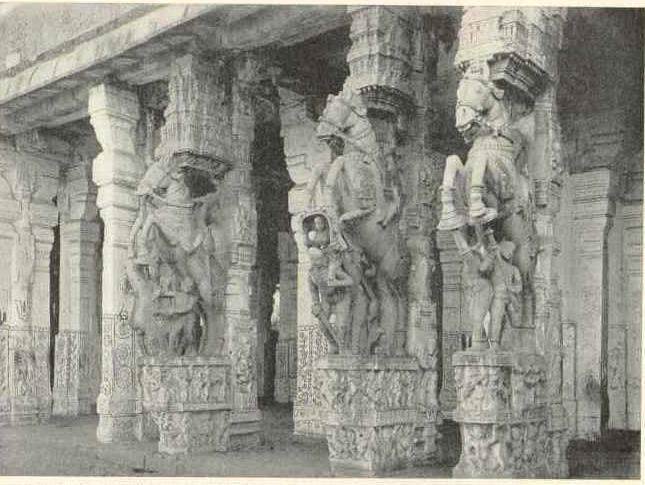|
Ramabhadramba
Rāmabhadrāmbā was a poet and consort of the Thanjavur Nayak king Raghunatha Nayak (r. 1600–34). She wrote the Sanskrit epic '' Raghunathabhyudayam'', a biography of her husband. Ramabhadramba was also a disciple of the Telugu poet Chengalva Kalakavi. Tharu and Lalita says that she "could compose poetry in three languages and was an expert in '' Ashtavadhanam'' (the capacity to attend to eight different intellectual activities at the same time)." They also claim that she was a historian who left behind "accounts of the political and military events in Raghunandanayaka's reign" and has documented the presence of several women composers in the court. References * * Tharu, Susie and K. Lalita (Ed.). "Introduction." Women Writing in India. 600 B.C to the Present. New York: The Feminist Press, 1991. * Rāmabhadrāmbā, 'Raghunāthābhyudayam', in ''Sources of Vijayanagar History (Selected and Edited for the University)'', ed. by S. Krishnaswami Ayyangar nd A. Rangaswami ... [...More Info...] [...Related Items...] OR: [Wikipedia] [Google] [Baidu] |
Raghunatha Nayak
Raghunatha Nayak was the most powerful king of the Thanjavur Nayak Dynasty. He was the third ruler of Thanjavur, southern India, from the Nayak dynasty. He ruled from 1600 to 1634 and is noted for the attainments of Thanjavur in literature, art, and Carnatic music. Early life Raghunatha Nayak was the eldest son of Achuthappa Nayak and was born after intense penance by his father. The '' Raghunathabhyudayam'' and ''Sahityanatyakara'' give a detailed account of his childhood. As a boy, Raghunatha learned the shastras, the art of warfare and administration. He had multiple queens, chiefly Kalavati referred to in the ''Raghunathabhyudayam'' as Pattampurani. Ramabhadramba, who wrote a history of the Thanjavur Nayak dynasty, was one of his concubines. In his early days, Raghunatha won acclaim fighting the Golconda Sultanate. He ascended the throne in 1600, ruled with his father from 1600 to 1614, and as sole monarch from 1614 to 1634. Campaigns and wars In 1614, Sriranga II, ... [...More Info...] [...Related Items...] OR: [Wikipedia] [Google] [Baidu] |
Thanjavur Nayak
The Thanjavur Nayak kingdom or Thanjavur Nayak dynasty were the rulers of Thanjavur in the 15th and 17th centuries. The Nayaks of the Balija social group, were originally appointed as provincial governors by the Vijayanagara Empire, Vijayanagara Emperor in the 15th century, who divided the territory into Nayak kingdoms which were Madurai, Tanjore, Gingee and Kalahasthi. In the mid 15th century they became an independent kingdom, although they continued their alliance with the Vijayanagara Empire. The Thanjavur Nayaks were notable for their patronage of literature and the arts. A translation from ''Raghunathabhyudayam (p. 284)'', says this about Timma Nayak the father of Sevappa Nayak, the founder of the Tanjore Nayak in line: ''In the sathria caste born from the feet of Vishnu was born a king called Timma Nayak''.''Nayaks of Tanjore'', by V. Vriddhagirisan, p.26 The ''Mannaru'' (Vishnu) of the Rajagopalaswamy Temple, Mannargudi, Mannargudi temple was their ''kula daivam'' (famil ... [...More Info...] [...Related Items...] OR: [Wikipedia] [Google] [Baidu] |
Tanjore Nayak Kingdom
Thanjavur (), also Tanjore,#Pletcher, Pletcher 2010, p. 195 is a city in the States and union territories of India, Indian state of Tamil Nadu. Thanjavur is the 11th biggest city in Tamil Nadu. Thanjavur is an important center of South Indian culture, South Indian religion, art, and architecture. Most of the Great Living Chola Temples, which are World Heritage Sites, UNESCO World Heritage Monuments, are located in and around Thanjavur. The foremost among these, the Brihadeeswara Temple, is located in the centre of the city. Thanjavur is also home to Tanjore painting, a painting style unique to the region. Thanjavur is the headquarters of the Thanjavur District. The city is an important agricultural centre located in the Cauvery Delta, Kaveri Delta and is known as the ''Rice bowl of Tamil Nadu''. Thanjavur is administered by a Thanjavur Municipal Corporation, municipal corporation covering an area of and had a population of 290,720 in 2011. Roadways are the major means of tra ... [...More Info...] [...Related Items...] OR: [Wikipedia] [Google] [Baidu] |


